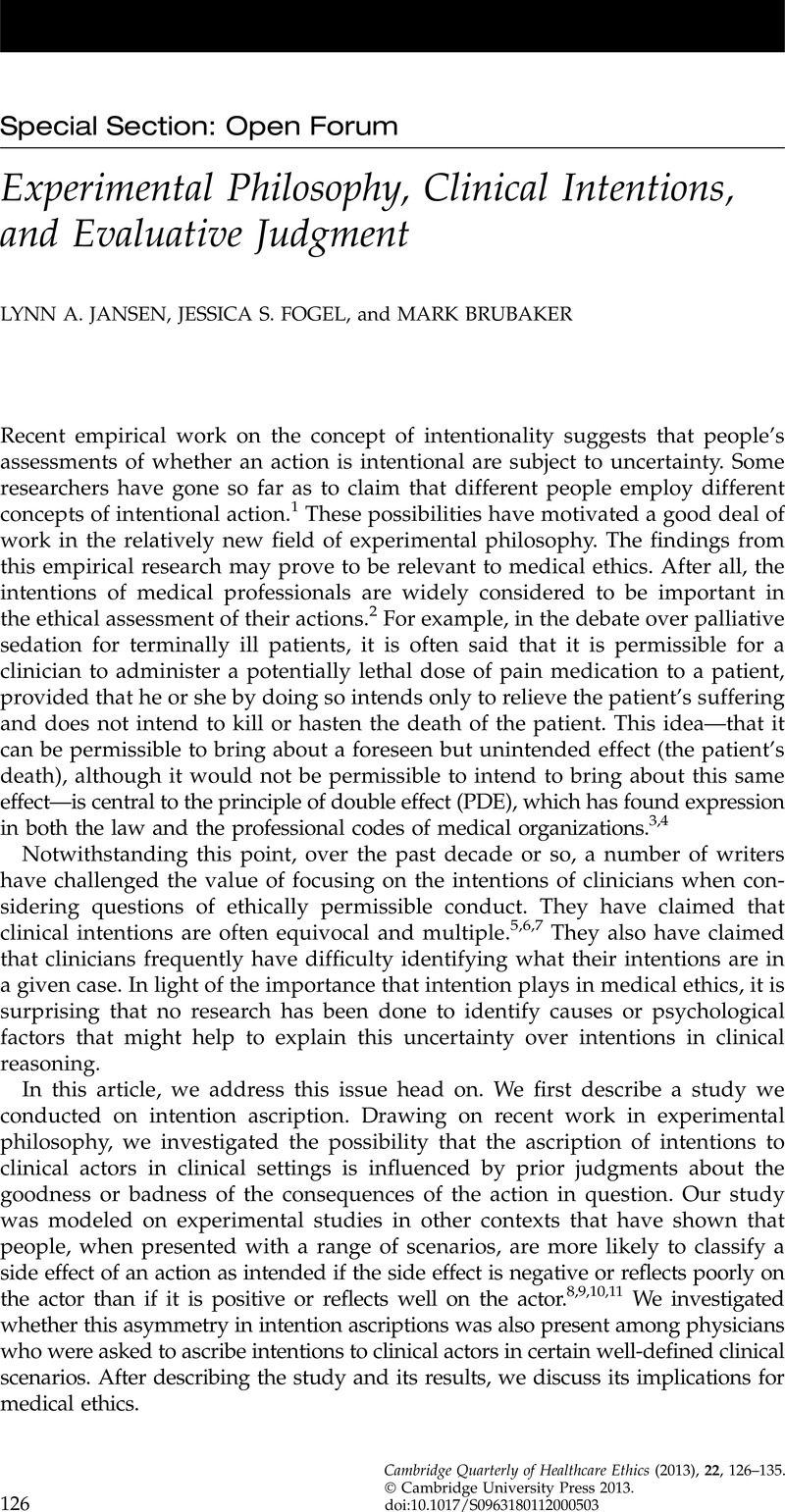Article contents
Experimental Philosophy, Clinical Intentions, and Evaluative Judgment
Published online by Cambridge University Press: 14 March 2013
Abstract

- Type
- Special Section: Open Forum
- Information
- Copyright
- Copyright © Cambridge University Press 2013
References
Notes
1 Cushman F, Mele A. Intentional action: Two-and-a-half folk concepts? In: Knobe J, Nichols S, eds. Experimental Philosophy. New York: Oxford University Press; 2008:171–88.
2 Beauchamp TL, Childress JF. Principles of Biomedical Ethics. 4th ed. New York: Oxford University;1994, at 206–11.
3 Council on Ethical and Judicial Affairs. CEJA Report 5-A-08; 2008; available at http://ama.assn.org/amal/pub/upload/mm/369(last accessed 7 Nov 2009).
4 Vacco v. Quill, 117 S. Ct. 2293 (U.S. 1997).
5 Quill TE. The ambiguity of clinical intentions. New England Journal of Medicine 1993;14:1039–40.
6 Quill TE. Principle of double effect and end-of-life pain management: Additional myths and a limited role. Journal Palliative Medicine 1998;4:333–6.
7 Douglas CD, Kerridge IH, Rainbird KJ, McPhee JR, Hancock L, Spigelman AD. The intention to hasten death: A survey of attitudes and practices of surgeons in Australia. Medical Journal of Australia 2001;175:511–51.
8 Knobe J. Intentional action in folk psychology: An experimental investigation. Philosophical Quarterly 2003;16:309–24.
9 Knobe J. Intentional action and side-effects in ordinary language. Analysis 2003;63:190–3.
10 Nadelhoffer T. Bad acts, blameworthy agents, and intentional action: Some problems for juror impartiality. In: Knobe J, Nichols S, eds. Experimental Philosophy. New York: Oxford University Press; 2008, at 148.
11 Mele AR. Intentional action: Controversies, data, and core hypothesis. Philosophical Psychology 2003;16:325–40.
12 See note 5, Quill 1993.
13 See note 6, Quill 1998.
14 See note 7, Douglas et al. 2001.
15 Douglas C, Kerridge I, Ankeny R. Managing intentions: The end-of-life administration of analgesics and sedatives and possibly slow euthanasia. Bioethics 2008;22(7):388–96.
16 See note 15, Douglas et al. 2008.
17 In a previous study, two of us asked first- and second-year medical students to attribute intentions to actors in well-defined clinical scenarios. See Jansen LA, Fogel JS. Ascribing intentions in clinical decision-making. Journal of Medical Ethics 2010 Jan:2–6. This study provided preliminary evidence for the view that the ascription of intentions to clinical actors is strongly influenced by prior evaluative judgments. But this study, suggestive as it was, did not rule out the possibility that the intention ascriptions of practicing clinicians differ significantly from those of relatively inexperienced medical students.
18 See note 8, Knobe 2003.
19 See note 9, Knobe 2003.
20 Knobe J. The concept of intentional action: A case study in the uses of folk psychology. Philosophical Studies 2006;130:203–31.
21 See note 8, Knobe 2003.
22 See note 8, Knobe 2003.
23 Knobe J, Nichols S, eds. Experimental Philosophy. New York: Oxford University Press; 2008, at 148.
24 See note 11, Mele 2003.
25 See note 17, Jansen, Fogel 2010.
26 Lagnado DA, Channon S. Judgments of cause and blame: The effects of intentionality and foreseeability. Cognition 2008;108:754–70.
27 Knobe’s research has attracted its share of critics. Some have claimed that there are special features of intentional action that explain the asymmetric responses. For a response to the critics, and an updated discussion of the issue, see Pettit D, Knobe J. The pervasive impact of moral judgment. Mind and Language 2009;24(5):586–604.
28 Nichols S, Ulatowski J. Intuitions and individual differences: The Knobe effect revisited. Mind and Language 2007;22(4):346–65.
29 Scanlon TM. Moral Dimensions. Cambridge, MA: Harvard University Press; 2008.
30 Jansen LA. Disambiguating clinical intentions: The ethics of palliative sedation. Journal of Medicine and Philosophy 2010 Jan:1–13.
31 See note 29, Scanlon 2008
- 3
- Cited by




